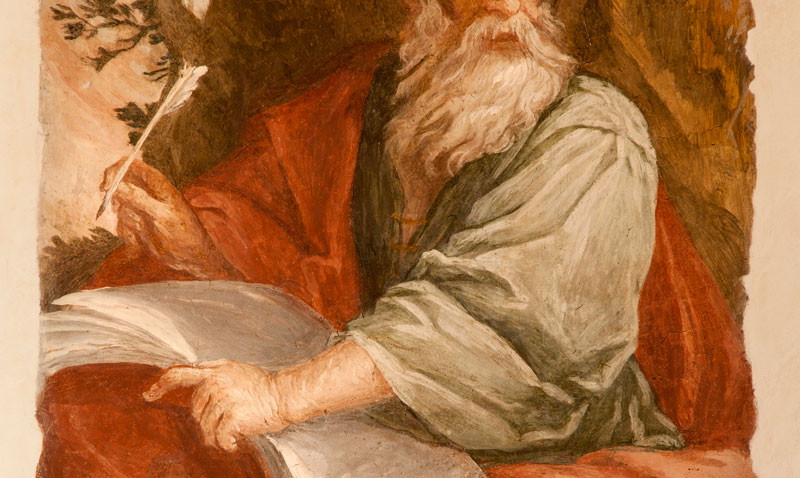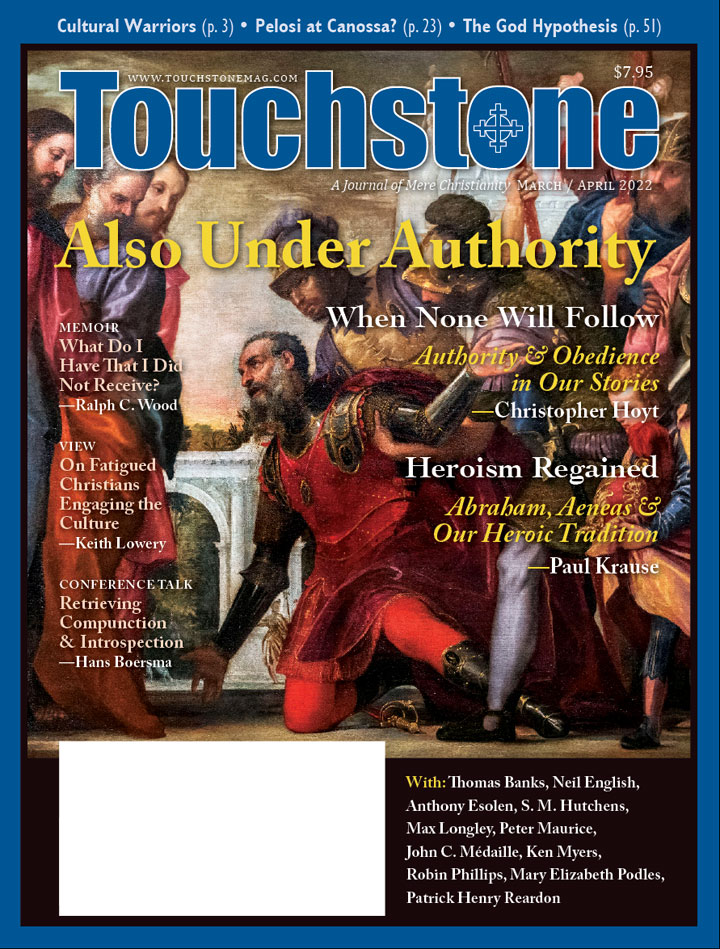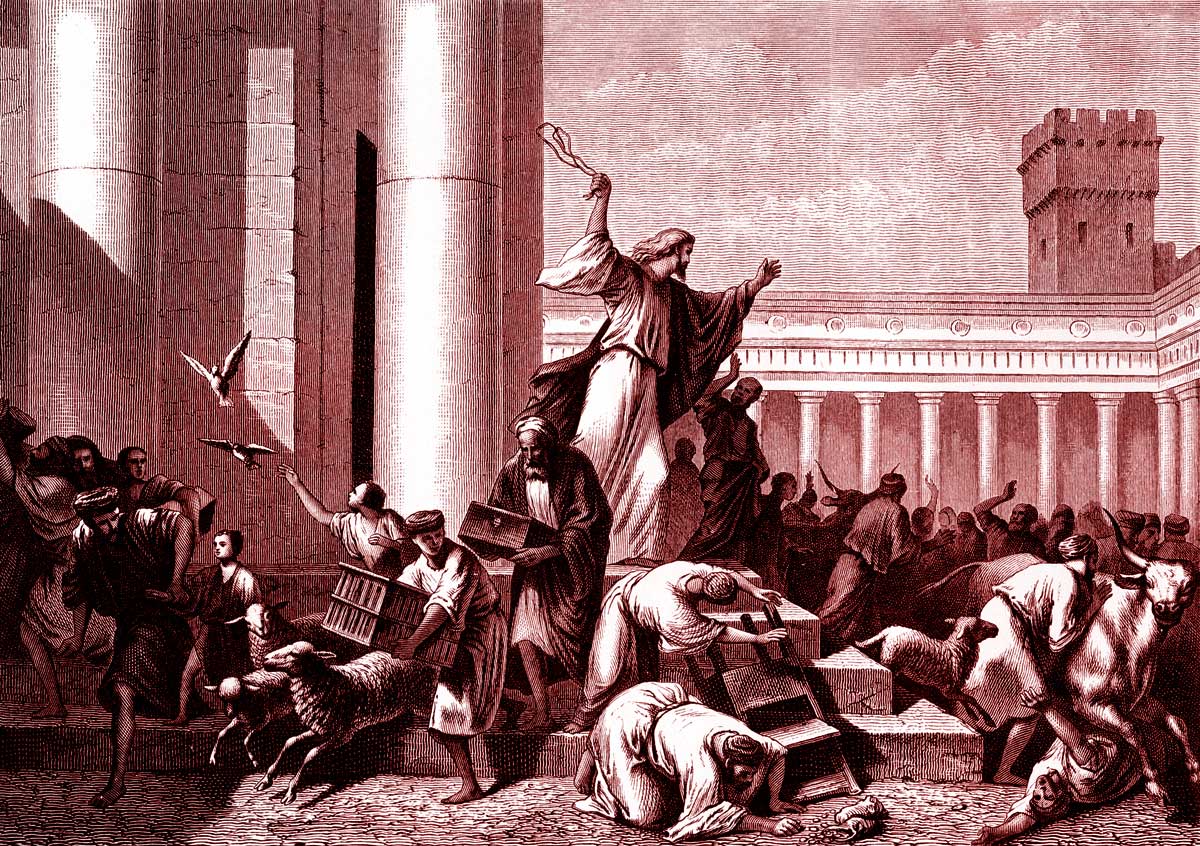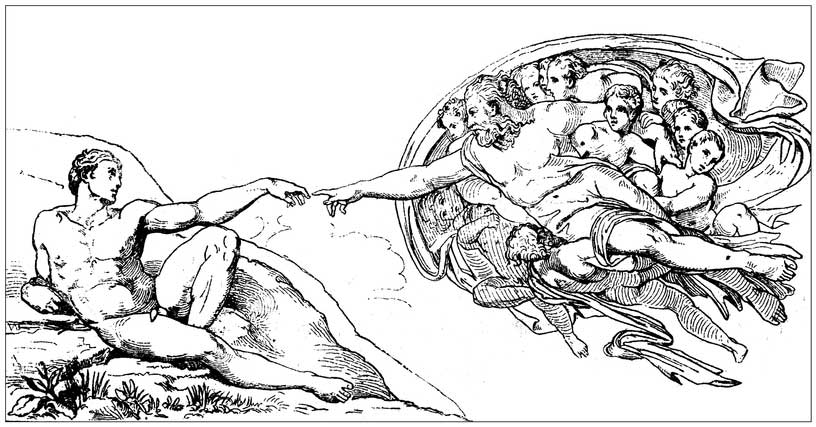Let's Talk About Sin
Retrieving Compunction & Introspection
I want to talk with you about sin. People always talk about sin, but typically we find it easiest to talk about the sins of others and about sins that are corporate—social ills of one kind or another. I suspect one of the reasons we don't mind talking about social justice is that it keeps the gaze away from ourselves. I won't be talking either about the sins of others or about social ills. Not that they're not real or unimportant; it's just that they're not neglected. We talk lots about them, sometimes too much. But talk about our own, personal sins is something I think needs retrieval, for if anything is neglected in our secular age, it is personal sin. Introspection has obtained a bad reputation also among theologians who, like Krister Stendahl and others, chastise the so-called "introspective conscience of the West."
We've become suspicious of forebears like Augustine and Anselm, for we have learned to begin theological talk with Christ—that is to say, with grace and forgiveness—since we see the character of God most clearly in Christ. Let me say up front that theological talk should begin with Christ. He is the Alpha and the Omega, the Beginning and the End. We do see the face of God sacramentally in Christ.
Still, I'm going to make a plea for a retrieval of sin, a theology of personal sin that through compunction and introspection yields purification and healing. Beginning with Christ means beginning with grace. But, as I hope to make clear, this grace involves recognition of how unlike Christ we are, so we may become more like him, being renewed in him. The introspection for which I want to make a plea is not without pain. But when it comes to hamartiology (the doctrine of sin), the saying holds true: no pain, no gain.
Our retrieval of sin is going to take the form of a retrieval of well-known spiritual writers—their talk about sin. We'll learn from them what it means to turn inward, there to see the wounds that fester, so they can be healed by the divine physician.
Compunction: Joyful Sorrow
It is divine revelation—God in Christ, biblical words—that leads to the compunction or grief over sin that I want to discuss. Words often involve violence and pain. Writing—reflecting, I think, the healing pain caused by the Word—used to be a rather physical, violent activity. Mary Carruthers's description of how writing functioned in the premodern world may be somewhat unnerving:
We should keep in mind the vigorous, if not violent, activity involved in making a mark upon such a physical surface as an animal's skin. One must break it, rough it up, "wound" it in some way with a sharply pointed instrument. Erasure involved roughing up the physical surface even more: medieval scribes, trying to erase parchment, had to use pumice stones and other scrapers. In other words, writing was always hard, physical labor, very hard as well on the surface on which it was being done; this vigorous physical aspect, I believe, was always part of that master-model of memory as a written surface. (The Craft of Thought: Meditation, Rhetoric, and the Making of Images, 400–1200, Cambridge University Press, 1998)
In our age of computers, we tend to forget the harsh and laborious character of writing throughout most of history. Carruthers's phrase "memory as a written surface" makes the point that not only was writing a rough, physical activity, but reflection upon the Word—meditation or memorization—was, too. Technology may have made writing easier, but meditation hasn't lost its demanding character.
The "wounding" of the parchment that Carruthers mentions is matched by a "wounding" of the mind in reflection or meditation upon divine revelation. In other words, it is not just writing but also the reading of words that can be painful. The word compunction gives us a sense of just how painful the processof reading can be. The Latin term compunctio speaks of the reader being painfully "pierced" in confrontation with the text. The language of compunction comes from the Latin pungere—to pierce or puncture. What biblical reading does—if we do it as it is meant to be done—is to violently pierce the core of our being.
The monastic writers took the term compunctio from the book of Acts. When Peter finished his Pentecost sermon, the people who heard it "had compunction in their heart"—compuncti sunt corde in the Vulgate (Acts 2:37). Contemporary versions often translate that they were "cut to the heart." Compunction means that being confronted with God's revelation in Christ is painful in character. Perhaps the primary and most difficult cost of discipleship is the pain of compunction over personal sin. This is not to say that compunction is simply about morbid introspection. Contemplation, joy, and peace are the result. And it is not always and only sin, but sometimes also joy that pierces the heart. Either way, the heart must be pierced for God in Christ to heal us and for usto reach our desired end.
Compunction & Comfort
Having travelled from Palestine to Lower Egypt in the late fourth century, John Cassian and his friend Germanus sat down at Abba Isaac's feet to learn from him about prayer and compunction. Cassian reports the interaction in his ninth Conference. Abba Isaac explains to the two young pilgrims the various types of prayer, paying special attention to "living pure prayer," which combines each of the types of prayer into one, and which "the Spirit lifts up to God in unspeakable groanings." The state of mind that results is shaped "by the contemplation of God alone and by the fire of love." Abba Isaac then elaborates on the petitions of the Lord's Prayer, since this prayer contains the "fullness of perfection" and carries us to the ineffable "prayer of fire," which rises "beyond all human consciousness."
The transition to this ineffable prayer of fire—which is the state of contemplation itself—is marked by compunction. In other words, for Abba Isaac, compunction is the moment we move from meditation and the various types of prayers to contemplation in ineffable prayer. He explains that different activities can bring on this prayer of fire: singing the psalms or listening to one of the brothers sing them; the spiritual discourse of a perfect man; the death of a brother or friend; or even the memory of one's own lack of warmth and carelessness. Each of these is an occasion that the Spirit may use to induce compunction in the soul.
For John Climacus, the seventh-century monk from the monastery on Mount Sinai, compunction (katanyxis) is pretty much the same thing as mourning (penthos). He discusses them together in Step 7 of The Ladder of Divine Ascent. St. John defines compunction as "an eternal torment of the conscience which brings about the cooling of the fire of the heart through silent confession." It is sin that causes the conscience to be in pain. "True compunction," writes John, "is pain of soul without any distraction." This pain over sin has to do with confession and repentance, for only they cause the sorrow that we need. In such pain, we cannot but mourn our sin. Mourning, explains Climacus, "is a melancholy of the soul, a disposition of an anguished heart that passionately seeks what it thirsts for." If he does see a difference between compunction and mourning, Climacus doesn't bother to explain. He treats the two as interchangeable.
Both expressions are closely linked also with what Climacus calls the "gift of tears." The pain of mourning leads to tears. He calls it a gift, for the tears often come unexpected, and the Lord comes uninvited, without us striving for it. But this gift is not one for which we should passively wait. St. John counsels us, "Do not cease laboring for it," and he tells us to "hold fast to it." We should recall both our sins and the judgment of God, so that the tears will come: "Never stop imagining and examining the abyss of dark fire, its cruel minions, the merciless inexorable judge, the limitless chaos of subterranean flame, the narrow descents down to underground chambers and yawning gulfs, and other such images." Mourning is the result both of God graciously entering the soul and of us reflecting on our sin. Climacus regards both perspectives as equally valid.
But why mourn if it involves this incredible cost of detesting our lives, keeping the fires of hell before our eyes, and experiencing agonizing pain? Climacus explains that compunction leads to joy and consolation. As soon as we experience the pain of compunction, comfort mixes in and takes over. "Inward joy and gladness mingle with what we call mourning and grief, like honey in a comb," he says. "God secretly brings consolation," and when it arrives, we are just like children, laughing and crying at the same time. Climacus even invents a new word to describe this mingling of joy and grief in compunction. He calls it charmolypē, a term made up from the Greek words for "joy" (charma) and "grief" (lypē). In "joyful grief," joy enters into the grief. Or, as Climacus also puts it, the fear lifts and "joy comes dawning." Compunction, while driven by sorrow for sin and fear of hell, invariably gives way to comfort and joy, a foretaste of eternal life.
Tears & No Tears
For Cassian and Climacus, compunction entails great inward turmoil. Being confronted with God's self-revelation can be an emotional rollercoaster. Its very purpose is to transform us, and the only way to get there is by allowing the Scriptures to speak into our lives. Scripture interprets the reader as much as the reader interprets Scripture. Indeed, we read two books at the same time: the book of Scripture and the book of experience.
The great Cistercian writer Bernard of Clairvaux begins the third of his Sermons on the Song of Songs (ca. 1135) with the comment:
Today we read the book of experience (libro experientiae). Let us turn to ourselves and let each of us search his own conscience about what is said. I want to investigate whether it has been given to any of you to say, "Let him kiss me with the kiss of his mouth" (Song 1:1). Few can say this wholeheartedly. But if anyone receives the spiritual kiss of Christ's mouth he seeks eagerly to have it again and again. I think no one can know what it is except he who has received it.
The bride's bold request, "Let him kiss me with the kiss of his mouth" confronts us with our own experience. Our own life is a book—liber experientiae—opened to us as we open the book of Scripture.
Just as the book of Scripture opens to us the book of experience, so it is our personal experiences that give us access to the inward sense of Scripture. After speaking at some length about the "blessed tears" that come to us through prayerful meditation on Scripture, Guigo II, the twelfth-century prior of the Grande Chartreuse, questions why he even bothers with this talk about the sweetness of tears:
Why do we try to express in everyday language affections that no language can describe? Those who have not known such things do not understand them, for they could learn more clearly of them only from the book of experience (libro experientiæ) where God's grace itself is the teacher. Otherwise it is of no use for the reader to search in earthly books: there is little sweetness in the study of the literal sense, unless there be a commentary (glossam), which is found in the heart, to reveal the inward sense. (The Ladder of Monks: A Letter on the Contemplative Life and Twelve Meditations, Cistercian Publications, 1981)
According to Guigo, it is useless to try to explain the ineffable realities that the reading of Scripture makes present to us. Instead, it is the book of experience that functions like a gloss or commentary; experience reveals the spiritual or inward sense of Scripture.
The flipside of these observations is that whenever we lack experience, this becomes a pressing issue in trying to search the spiritual depth of Scripture: how can we reach the inward sense if we don't have the liber experientiae that allows us to read the Scriptures well?
Bernard, for his part, clearly worried about this. A person who has already experienced Christ's spiritual kiss mentioned at the beginning of the Song of Songs can legitimately pray with David, "Restore unto me the joy of thy salvation" (Ps. 51:12). But Bernard isn't convinced he can put this prayer on his lips. "A soul like mine," he comments, "burdened with sins, cannot dare say that, while it is still crippled by fleshly passions (1 Tim. 3:6), and while it does not feel the sweetness of the Spirit, and is almost wholly unfamiliar with and inexperienced (inexperta) in inner joys" (Sermon 3.1.1). The requirement of feeling or emotion means that lack of experience (inexperta) precludes one from understanding Scripture, which in turn serves to keep the desired experience beyond reach.
Bernard's worry is one that has troubled many spiritual writers. Precisely because Scripture confronts our lives—including our sins and shortcomings—monastic authors often worried that their lack of experience exposed them as hypocrites. Germanus, John Cassian's fellow pilgrim to the Egyptian desert, knew of a sorrow and grief that sometimes melted him into tears—which in turn gave him great joy. But he also worried that sometimes the tears stayed away:
Sometimes it has happened to me that wishing once more for these tears of compunction to flow I have spent all my efforts on this. I recall to mind all my mistakes and all my sins, and still I cannot recover that rich abundance of tears. My eyes stay dry, like the hardest stone, and not even the tiniest drop is shed. And just as I rejoice in that outflowing of tears, so I grieve when I cannot recover it at will. (Conference 9.28)
The grave implications of dry eyes deeply concerned Germanus. Sometimes he grieved, but the grief wasn't matched by tears.
Anselm's Dilemma
Nowhere perhaps is anxiety over lack of tears expressed more poignantly than in Anselm's Prayers and Meditations, most of which he initially sent in 1072 to Adelaide, daughter of William the Conqueror. Ladies at court such as Princess Adelaide and Countess Matilda of Tuscany used Anselm's prayers and meditations for their personal devotions. The Benedictine abbot tells them in his preface that the purpose of the prayers and meditations is "to stir up the mind of the reader to the love or fear of God, or to self-examination. They are not to be read in a turmoil, but quietly, not skimmed or hurried through, but taken a little at a time, with deep and thoughtful meditation." Anselm cautions his reader to read only as much as is "useful in stirring up his spirit to pray," and that the reader "can begin and leave off wherever he chooses."
In short, Anselm's prayers and meditations were meant to function much like the biblical text itself: their purpose is meditation, compunction, and, ultimately, contemplation. Anselm—and in this he would be followed by many other monastic writers over the next few centuries—offered his own writing as material for those same purposes.
The abbot from Bec, Normandy, ratchets up the emotional tension to an unprecedented level. He consistently abases and chastises himself—no matter who it is that he addresses in prayer, whether Christ, Mary, John the Baptist, Peter, Paul, Stephen, or Benedict. Anselm is deeply troubled by his lack of emotion and lack of tears. In his prayer to St. Paul, he appears to see no way out, since he fails to "dissolve entirely in tears." And without these tears, what hope does he have? "When truly, because of my wretchedness, feeling and grief are not in me, how can I hope? Without hope, how can I pray? And without prayer, what can I obtain?" Anselm is convinced that his sins condemn him before God. He calls out in his prayer to St. John the Evangelist: "Grief, sorrow, groans, sighs, where are you present if here you are absent? Where are you fervent if here you are tepid?"
Anselm considers his dilemma well-nigh insuperable. In the first of his three prayers to St. Mary, he confesses this about his sins: "If they are concealed they cannot be healed, if they are seen they are detestable." Anselm fears he is incapable of paying the high price of discipleship. Praying to St. John the Baptist, he acknowledges:
If I look within myself, I cannot bear myself;
if I do not look within myself, I do not know myself.If I consider myself, what I see terrifies me;
if I do not consider myself, I fall to my damnation.If I look at myself, it is an intolerable horror;
if I do not look at myself, death is unavoidable.Evil here, worse there, ill on every side;
but there is too much evil here,
too much that is worse there,
too much ill on every side.
Eileen Sweeney captures the double bind of Anselm's dilemma quite well: he "cannot reveal his sins because they are 'detestable' and would make him detested, but, on the other hand, sins cannot be forgiven unless they are confessed" (Anselm of Canterbury and the Desire for the Word, Catholic University of America Press, 2002).
How to overcome this double bind? To begin, we should look to the practices of prayer and meditation. The way I see it is that Anselm intended his prayers and meditations—that is to say, the very practice of praying and meditating—as the means to overcome the dilemma. Anselm may say that he is incapable of confessing his sins, but of course his prayers do exactly that. And it was surely his hope that when Adelaide, Matilda, and others would use them meditatively, they would be so pierced by compunction and so haunted by desire as to make these prayers experientially their own.
By using these prayers and meditations for the purpose of therapeutic healing, his readers could deal with their sinfulness and so bridge the gap between heaven and earth. The result was an introspective spirituality—with an emphasis on self-abasement—hitherto unknown in Christian tradition. The so-called "Anselmian transformation" (see R. W. Southern, Saint Anselm: A Portrait in a Landscape, Cambridge University Press, 1990, chap. 5) placed the individual naked before God, agonizing over his unworthiness with an unparalleled exuberance of expression.
Theologies of tears invariably have a shadow side, and each of the monastic writers we have looked at struggled with it: sometimes the tears don't come. Sometimes, the much-vaunted experience is simply absent. None of these authors, however, ends in despair. Even Anselm must have experienced enough of the presence of God that he turned back again and again to the Scriptures, in order, yet again, to seek the face of God.
Scriptural Tears
Those meditating upon Scriptureover the centuries have recognized their own experience of weeping in the biblical text. Abba Isaac explains to Cassian and Germanus the different types of tears through a biblically construed taxonomy (Conference 9.29).
The first type of tears is that caused by the thorn of our sins. Scripture gives examples of this in Psalm 6:6 ("I have laboured in my groanings, every night I will wash my bed: I will water my couch with my tears") and in Lamentations 2:18 ("Let tears run down like a torrent day and night: give thyself no rest, and let not the apple of thy eye
cease").
Then there are tears that flow from the contemplation and longing of eternity, as in Psalm 42:2–3 ("When shall I come and appear before the face of God? My tears have been my bread day and night"). A third type of tears is caused by fear of hell and judgment, as expressed in Psalm 143:2 ("Enter not into judgment with thy servant: for in thy sight no man living shall be justified"). Yet another kind of tears is caused by the sinfulness of others, as when Samuel wept over Saul (1 Sam. 15:35) or the Lord wept for Jerusalem (Luke 19:41).
And finally, sometimes believers simply express their worries and anxieties with tears to the Lord. Jeremiah did so when he cried, "Who will give water to my head, and a fountain of tears to my eyes? and I will weep day and night for the slain of the daughter of my people" (Jer. 9:1); as did also the poor, worried man who poured out his complaint to the Lord in Psalm 102: "I did eat ashes like bread, and mingled my drink with weeping" (v. 9).
Abba Isaac explains that each of these five types of tears has biblical precedent.
Bible, Imagination & Tears
Scripture is prominent also when the English Cistercian abbot, Aelred of Rievaulx, talks about tears. Aelred, however, does not simply point to biblical precedent. Instead, he employs a rhetorical strategy sometimes referred to as "composition of place." Aelred asks his readers to imaginatively enter into the place of the weeping biblical characters. He does this, for example, in Jesus at the Age of Twelve. Here the abbot traces Jesus' birth in Bethlehem, his upbringing in Nazareth, and his first journey to Jerusalem as a 12-year-old. Aelred wrote the book some time between 1153 and 1157 for Yvo, a monk of Warden Abbey in Bedfordshire, a daughter house of Rievaulx.
Aelred turns to the theme of tears when he tells Yvo to meditate on Christ's goodness by entering the house of Simon the Pharisee and watching how, with mercy, Jesus looks upon the sinful woman who washes his feet with "tears of repentance" (cf. Luke 7:36–50). "Kiss, kiss, kiss, blessed sinner, kiss those dearest, sweetest, most beautiful of feet," Aelred exhorts his reader. The Pharisee may not repent, but for the blessed sinner, conversion is possible. Taken up in the emotional frenzy, Aelred addresses his own soul, as he identifies with the sinful woman:
What are you about, my soul, my wretched soul, my sinful soul? There certainly is the place for you safely to shed your tears, to atone for your impure kisses with holy kisses, to pour out all the ointment of your devotion free from fear, without any touch or movement of vice to tempt you. Why do you hold back? Break forth, sweet tears, break forth, let no one check your flowing. Water the most sacred feet of my Savior, of my Champion. I do not care if some Pharisee mutters, if he thinks I should be kept away from his own feet, if he judges me unworthy to touch the hem of his own garment. Let him mock, let him laugh and jeer, let him turn his eyes away, let him hold his nose; for all that I will cling to your feet, my Jesus, I will hold them fast with my hands, press my lips to them, and I will not stop weeping and kissing them until I am told: "Many sins have been forgiven her, because she has loved much" [cf. Luke 7:47].
The Cistercian abbot often draws his readers into the narrative by suggesting that they identify with characters in the narrative who are close to Jesus. Time and again, this allows for tears of repentance to flow, so that his readers can experience the love of Jesus.
The abbot of Rievaulx does something similar when he tells his sister in A Rule of Life for a Recluse (ca. 1160–1162) to follow Peter to the High Priest's courtyard, reminding her that this is the place where Peter "comes to his right mind and weeps bitterly" (Luke 22:62). Reflecting on the three-hour darkness at the Crucifixion, the spiritual master insists that his sister should weep with the sun over Christ's death: "It is not surprising if when the sun mourns you mourn too, if when the earth trembles you tremble with it, if when rocks are split your heart is torn in pieces, if when the women who are by the Cross weep you add your tears to theirs (collacrymaris)." This last verb—a combination of con ("with") and lacrimare ("to weep")—articulates precisely what Aelred expects his sister to do: enter the biblical narrative and join the women at the Cross in their weeping.
Aelred encourages his sister to keep Mary Magdalene company as she visits the tomb. Referencing John 20:11—"Mary stood at the sepulchre without, weeping. Now as she was weeping, she stooped down and looked into the sepulchre"—Aelred tells his sister to weep with Mary as Jesus sweetly calls to her, "Mary!"
At this utterance let all the floods burst forth, let tears stream up from the very bottom of your heart, let sighs and sobs issue from your inmost depths. "Mary." O blessed one, what did you think, what did you feel, when you prostrated yourself at this utterance and answered his greeting with the cry: "Master"? Tears preclude any further utterance as the voice is stifled by emotion and excess of love leaves the soul dumb, the body without feeling.
When Jesus tells her not to touch him, the anchoress does not give up:
Why may I not touch you? May I not touch, may I not kiss those lovable feet, for my sake pierced with nails and drenched in blood? Are you less gentle than usual because you are more glorious? But I will not let you go, I will not leave you, I will not spare my tears, my breast will burst with sobs and sighs unless I touch you.
Aelred asks his sister (as well as other anchoresses) to take her own place within the passion narrative, to identify personally with key figures such as Peter and Mary, making their tears her own.
Indispensable Food
Opening ourselves up to discipleshipis not for the faint of heart. Its cost is a heart pierced in fierce, agonizing pain. Compunction or piercing (pungere) of the soul is often marked by tears, so much so that the absence of tears often caused emotional upheaval. Reading some of the spiritual masters on being confronted with the biblical textcan easily raise apprehensions and fears of the implications. If Bernard hardly thought he knew the book of experience, and if Anselm struggled to bridge the gap between his sin and God's face, aren't our rudimentary attempts at meditative reading cavalier and presumptuous?
Perhaps. But if anything stands out in the authors we have looked at, it is that compunction is biblical. Scripture itself models for us the grief of compunction. This, at least, was the conviction of these medieval authors. When they scoured the biblical text, they saw their own pangs of conscience and their own tears reflected all over the place. When we follow along with Aelred's imaginative entries into the biblical text, doesn't it strike us as right that, with the sinful woman, we kiss the feet of Jesus, shedding tears of repentance (cf. Luke 7:36–50)? Medieval spiritual writers turned to Scripture as the source for their teaching on tears.
We have for too long ignored the language of sin, thinking perhaps we can rely upon God's cheap grace. Insisting on starting with grace, at times we may fail to discuss our own personal sin at all. But Christian traditionworks on the conviction that the Bible pries open our lives and exposes the secrets of our hearts. We need a retrieval of compunction and tears, for the joy of salvation rests upon experiential repentance from sin. Patristic and medieval authors, Eastern and Western theologians—they all engaged in introspection. They looked within, and it made them weep—for grace, for forgiveness, for renewal, for change.
An introspective conscience isn't the same as morbid despair. True, Bernard takes a dim view of his own experiences. But he also bashfully notes his brief moments of contemplation. Preaching on the Song of Songs 3:1 ("In my bed by night I sought him whom my soul loveth"), the Mellifluous Doctor writes, "Even though I also had been privileged sometimes to enjoy that favour, do you suppose it would be possible for me to describe the ineffable?" His introspection eventually brought him through compunction to the joy of seeing the face of God.
St. Anselm, I would say, is no different. True, his Prayers and Meditations maymake us apprehensive of lapsing into frightful anguish. But his introspective spirituality does not leave him or his readers without hope. Anselm asks us to read him as we would Scripture itself: with confidence that through a meditative reading of his prayers and meditations, we may be pierced and be changed. Anselm's introspection aims for the experience of a divine inbreaking of grace.
We should continue to learn from the spiritual masters of our tradition. They distinctly saw themselves as mystagogues. They were theologians in the ancient sense of the term: they saw their calling primarily as that of drawing others into the life of God. Their focus on introspection and compunction served a therapeutic purpose, clearing the ground for participation in the life of God.
Introspection, then, is not the same as morbid despair. That would be a deadly confusion. John Climacus's notion of "joyful grief" (charmolypē) should remind us that looking within allows the joy of eternity to enter our hearts. The bread of tears is indispensable food, for it is none other than the real presence of Christ.
Hans Boersma is the Saint Benedict Servants of Christ Professor in Ascetical Theology at Nashotah House Theological Seminary.
subscription options
Order
Print/Online Subscription

Get six issues (one year) of Touchstone PLUS full online access including pdf downloads for only $39.95. That's only $3.34 per month!
Order
Online Only
Subscription

Get a one-year full-access subscription to the Touchstone online archives for only $19.95. That's only $1.66 per month!
bulk subscriptions
Order Touchstone subscriptions in bulk and save $10 per sub! Each subscription includes 6 issues of Touchstone plus full online access to touchstonemag.com—including archives, videos, and pdf downloads of recent issues for only $29.95 each! Great for churches or study groups.
Transactions will be processed on a secure server.
more on Christianity from the online archives
more from the online archives
calling all readers
Please Donate
"There are magazines worth reading but few worth saving . . . Touchstone is just such a magazine."
—Alice von Hildebrand
"Here we do not concede one square millimeter of territory to falsehood, folly, contemporary sentimentality, or fashion. We speak the truth, and let God be our judge. . . . Touchstone is the one committedly Christian conservative journal."
—Anthony Esolen, Touchstone senior editor













